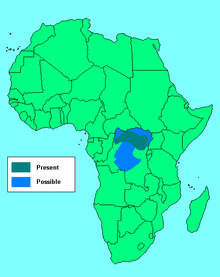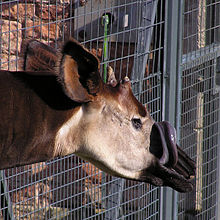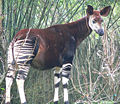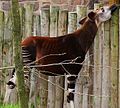- Okapi
-
Okapi 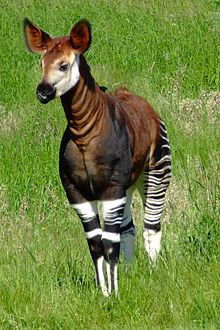
At Marwell Wildlife, England Conservation status Scientific classification Kingdom: Animalia Phylum: Chordata Class: Mammalia Order: Artiodactyla Family: Giraffidae Genus: Okapia
Lankester, 1901Species: O. johnstoni Binomial name Okapia johnstoni
(P.L. Sclater, 1901)Range map The okapi (pronounced /oʊˈkɑːpiː/), Okapia johnstoni, is a giraffid artiodactyl mammal native to the Ituri Rainforest, located in the northeast of the Democratic Republic of the Congo, in Central Africa. Although the okapi bears striped markings reminiscent of zebras, it is most closely related to the giraffe.
The animal was brought to prominent European attention by speculation on its existence found in popular press reports covering Henry Morton Stanley's journeys in 1887. Remains of a carcass were later sent to London by the English adventurer and colonial administrator Harry Johnston and became a media event in 1901.[2] Today there are approximately 10,000–20,000 in the wild and as of 2011, 42 different institutions display them worldwide.[3][4]
Contents
Etymology
The generic epithet Okapia derives from the Lese Karo name o'api,[citation needed] while the specific epithet (johnstoni) is in recognition of the explorer Sir Harry Johnston, who organized the expedition that first acquired an okapi specimen for science from the Ituri Forest in the Democratic Republic of the Congo.
The name "okapi" is a portmanteau of two Lese words, oka a verb meaning to cut and kpi which is a noun referring to the design made on Efé arrows by wrapping the arrow with bark so as to leave stripes when scorched by fire. The stripes on the legs of the okapi resemble these stripes on the arrow shafts. Lese legend says the okapi decorates itself with these stripes, adding to the okapi's great camouflage.[citation needed]
Characteristics and behaviour
Okapis have reddish dark backs, with striking horizontal white stripes on the front and back legs, making them resemble zebras from a distance. These markings possibly help young follow their mothers through the dense rain forest and may also serve as camouflage.[5][6]
The body shape is similar to that of the giraffe, except that okapis have much shorter necks. Both species have very long (approximately 35 centimetres),[7] flexible, blue tongues that they use to strip leaves and buds from trees.
The tongue of the okapi is also long enough for the animal to wash its eyelids and clean its ears (inside and out). This sticky tongue is pointed and bluish grey in colour like the giraffe's. Male okapis have short, skin-covered horns called ossicones. They have large ears, which help them detect their predator, the leopard.
Okapis are 1.9 to 2.5 metres (6.2 to 8.2 ft) long and stand 1.5 to 2.0 metres (4.9 to 6.6 ft) high at the shoulder. They have a 30 to 42 centimetres (12 to 17 in) long tail. Their weight ranges from 200 to 300 kilograms (440 to 660 lb). Okapis are primarily diurnal, although recent photo captures have challenged this long held assumption. One photograph taken at 02:33 am shows an okapi feeding in the Watalinga forest in the north of the Virunga National Park in eastern DRC, thus providing evidence that they do not only feed during the daytime.[citation needed] Okapis are essentially solitary, coming together only to breed, with the exception of mothers and offspring. Breeding behaviours include sniffing, circling and licking each other.[8]
Okapis forage along fixed, well-trodden paths through the forest. They have overlapping home ranges of several square kilometres and typically occur at densities of about 0.6 animals per square kilometre (about 1.5 animals per square mile). They are not social animals and prefer to live in large, secluded areas. This has led to problems with the okapi population due to the shrinking size of the land they live on. This lack of territory is caused by human land development and other social reasons.
Okapis have several methods of communicating their territory, including scent glands on each foot that produce a tar-like substance, as well as urine marking. Males are protective of their territory, but allow females to pass through their domain to forage.
Habitat
Okapis prefer altitudes of 500 to 1,000 m, but may venture above 1,000 m in the eastern montane rainforests. Because there is a considerable amount of rain in these forests, okapis have an oily, velvety coat of fur that repels the water. They develop this coat early in childhood also as a technique of camouflage.[9]
The range of the okapi is limited by high montane forests to the east, swamp forests below 500 m to the west, savannas of the Sahel/Sudan to the north, and open woodlands to the south. Okapis are most common in the Wamba and Epulu areas.
Diet
Okapis are herbivores, eating tree leaves and buds, grass, ferns, fruit, and fungi. Many of the plant species fed upon by the okapi are poisonous to humans.
Examination of okapi feces has revealed that the charcoal from trees burnt by lightning is consumed as well. Field observations indicate that the okapi's mineral and salt requirements are filled primarily by a sulfurous, slightly salty, reddish clay found near rivers and streams.
History
The okapi was known to the ancient Egyptians; shortly after its discovery by Europeans, an ancient carved image of the animal was discovered in Egypt.[10] Although the okapi was unknown to the Western world until the 20th century, it was possibly depicted 2,500 years ago on the facade of the Apadana, at Persepolis, as a gift from the Ethiopian procession to the Achaemenid kingdom.[11]
For years, Europeans in Africa had heard of an animal that they came to call the 'African unicorn'. In his travelogue of exploring the Congo, Henry Morton Stanley mentioned a kind of donkey that the natives called the 'Atti', which scholars later identified as the okapi. Explorers may have seen the fleeting view of the striped backside as the animal fled through the bushes, leading to speculation that the okapi was some sort of rainforest zebra.
When the British governor of Uganda, Sir Harry Johnston, discovered some pygmy inhabitants of the Congo being abducted by a showman for exhibition, he rescued them and promised to return them to their homes. The grateful pygmies fed Johnston's curiosity about the animal mentioned in Stanley's book. Johnston was puzzled by the okapi tracks the natives showed him; while he had expected to be on the trail of some sort of forest-dwelling horse, the tracks were of some cloven-hoofed beast.
Though Johnston did not see an okapi himself, he did manage to obtain pieces of striped skin and eventually a skull. From this skull, the okapi was correctly classified as a relative of the giraffe; in 1901, the species was formally recognized as Okapia johnstoni.[12]
The okapi is sometimes referred to as an example of a living fossil.[13]
The okapi was adopted as an emblem by the now defunct International Society of Cryptozoology.
In captivity
-
An okapi at Bristol Zoo cleans itself
-
Okapi at Chester Zoo
-
Okapis at Chester Zoo
As of 2011, there are 154 okapi specimens in zoos on four continents, with the majority of them in North American and European zoos, and two specimens in South Africa and seven specimens in Japan.[4][14] Immediately after their discovery, zoos around the world attempted to get okapis from the wild. These initial attempts were accompanied by a high mortality rate due to the rigors and stress of traveling thousands of miles by boat and by train. In more recent years, shipment by airplane has proven more successful.
The first live specimen in Europe arrived in Antwerp in 1918. The first okapi to arrive in North America was at the Bronx Zoo, via Antwerp, in 1937. The first okapi born in captivity outside Congo was at the Antwerp Zoo, Belgium in 1953.[citation needed] In North America, the first okapi was born at the Brookfield Zoo in Illinois in 1959. Brookfield Zoo records 27 okapi births, followed by Zoo Basel’s 21 births.[citation needed]
The Brookfield Zoo directs the Okapi Species Survival Plan for the Association of Zoos and Aquariums (AZA). The European Endangered Species Programme (EEP) for the okapi is led by the Antwerp Zoo.
Wild status
Although okapis are not classified as endangered, they are threatened by habitat destruction and poaching. The world population is estimated at 10,000–20,000. Conservation work in the Congo includes the continuing study of okapi behaviour and lifestyle, which led to the creation in 1992 of the Okapi Wildlife Reserve. The Congo Civil War threatened both the wildlife and the conservation workers in the reserve.
There is an important captive breeding centre at Epulu, at the heart of the reserve, which is managed jointly by the Congolese Institute for Nature Conservation (ICCN) and Gilman International Conservation,[15] which in turn receives support from other organisations including UNESCO, the Frankfurt Zoological Society and WildlifeDirect[16] as well as from zoos around the world. The Wildlife Conservation Society is also active in the Okapi Wildlife Reserve.
On June 8, 2006, scientists reported that evidence of surviving okapis in Congo's Virunga National Park had been discovered. This had been the first official okapi sighting in that park since 1959, after nearly half a century.[17] In September 2008, the Wildlife Conservation Society reported that one of their camera traps snapped the first photo ever taken of an okapi in Virunga National Park.[18]
In popular culture
In Restaurant at the End of the Universe by Douglas Adams as well as the original radio show of The Hitchhiker's Guide To The Galaxy, there is a line that states that Arthur Dent's brother was said to have been "nibbled to death by an Okapi".[19]
The English goth punk band The Damned ended their third album Machine Gun Etiquette, which was released originally in 1979 on a vinyl record, with a lead-out groove that contained the sound clip: "nibbled to death by an okapi", from the original HHGTTG radio show - spoken by Peter Jones. The vinyl record was engineered in such a way that when it hit that line, it would loop indefinitely until the listener physically removed the needle from the vinyl record. Of course, this is not possible on the CD or MP3 version of the album, so the original vinyl is a prized collectible to fans of the band and some extreme HHGTTG fans.[20]
Actor / comedian Michael Biggins AKA Blackout on several radio and television shows and interviews including VH1's I Love the 90s and on his radio & TV show Blackout's Box LIVE, also claims that he 'created' the okapi, and that it is his favorite animal and the "ruler of all universes" - only he originally called it a 'Gazebrahorseraf'. He ends and opens his Blackout's Box LIVE radio and TV show many times with the line, "All Hail the Thrice Great Okapi!" which is a play on the fact that the okapi appears to be a mixture of a giraffe, a horse, and a zebra, and an inside joke to people knowledgeable of occult magic. In one of the sketches of his improvisational 2010 Christmas Special of his live show he has an okapi puppet dancing with a cheap Santa Claus animatronic. He also has a puppet of Jen, the lead character from The Dark Crystal riding a toy okapi that can be seen weekly in the background of his live television show.[21]
See also
References
- ^ IUCN SSC Antelope Specialist Group (2008). Okapia johnstoni. In: IUCN 2008. IUCN Red List of Threatened Species. Downloaded on 10 April 2009. Database entry includes a brief justification of why this species is of near threatened.
- ^ Shaw, Albert (1918). The American review of reviews. http://books.google.com/?id=hpR_hPSqYa0C&pg=PA544&dq=Harry+Johnston+okapi#v=onepage&q=Harry%20Johnston%20okapi&f=false.
- ^ National Zoological Gardens of South Africa: National Zoo gets rare okapis.
- ^ a b "ISIS Species Holdings: Okapi johnstoni". International Species Holding Information System (ISIS). 2011-01-12. https://app.isis.org/abstracts/Abs77557.asp#1.0. Retrieved 2011-03-23.
- ^ "San Diego Zoo's Animal Bytes: Okapi". Sandiegozoo.org. http://www.sandiegozoo.org/animalbytes/t-okapi.html. Retrieved 2010-07-13.
- ^ "Okapi". Zsl.org. http://www.zsl.org/conservation/regions/africa/virunga/okapi,1009,AR.html. Retrieved 2010-07-13.
- ^ "Okapi" from Bristol Zoo Gardens. Retrieved September 24, 2010.
- ^ Animal Diversity Web: Okapia johnstoni - okapi.
- ^ San Diego Zoo's Kid Territory: Critters: Okapi.
- ^ Okapi - between legend and science from Zoo-E News March 2007 Number 2
- ^ Oriental Institute of the University of Chicago; photo detail. The Oriental Institute identifies the subject as an Okapi with a question mark.
- ^ Walker's Mammals of the World. Ronald M Nowak. 6th Ed. 1999. p1085.
- ^ "Why Is the Okapi Called a Living Fossil". The Milwaukee Journal. Jun. 24, 1954. http://news.google.com/newspapers?nid=1499&dat=19570624&id=wAMkAAAAIBAJ&sjid=kCUEAAAAIBAJ&pg=6731,2170969.
- ^ http://www.zoobasel.ch/aktuell/detail.php?NEWSID=343&PHPSESSID=af2d6b281198b393520ee48edcca7d1fZoo Basel
- ^ GIC
- ^ "WildlifeDirect Saving Endangered Animals". http://www.wildlifedirect.org.
- ^ World Wild Life article
- ^ Photo Reveals Rare Okapi Survives Poaching Onslaught Newswise, Retrieved on September 10, 2008. Many mainstream media outlets incorrectly reported that it was the first time an Okapi had ever been photographed anywhere in the wild.
- ^ "The Hitchhiker's Guide to the Galaxy interviews - page 280 & 281". the Hitchhiker's Guide to the Galaxy on Google Books. Oct. 12, 1979. http://books.google.com/books?id=ppLI3zTIhQ4C&pg=PA281&lpg=PA281&dq=douglas+adams+okapi&ct=result#v=onepage&q&f=false.
- ^ "The Damned Official History". The Damned the Band Official History. 2011. http://www.officialdamned.com/history.htm.
- ^ "The Blackout Christmas Special Spectacular". Blackout's Box LIVE. Dec. 25, 2010. http://www.youtube.com/watch?v=6jYadAyTwyE.
External links
- Gilman International Conservation - Okapi Conservation Project
- Okapi Reserve
- Brookfield Zoo - Okapi Species Survival Plan (SSP)
- BBC - Science & Nature - Wildfacts - Okapi
News links
- Rare African okapi seen in wild BBC News 2008-09-11
- Rare giraffe-like animal spotted (BBC News)
- The okapi management site
- Zoo announces birth of rare, endangered okapi
- First pictures in wild of elusive Okapi
- Wolfram Bell (Nov. 2009): "Okapis - geheimnisvolle Urwaldgiraffen. Entdeckungsgeschichte, Biologie, Haltung und Medizin einer seltenen Tierart." Schüling Verlag Münster, Germany. ISBN 978-3-86523-144-4.
Categories:- IUCN Red List near threatened species
- Even-toed ungulates
- Mammals of Africa
- Megafauna of Africa
- Fauna of the Democratic Republic of the Congo
- Giraffes
- Herbivorous animals
- Monotypic mammal genera
- Animals described in 1901
- Living fossils
Wikimedia Foundation. 2010.


